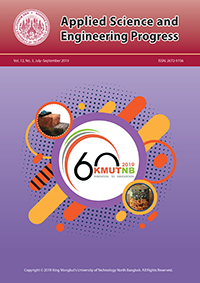Optimization of Semi-batch Reactive Distillation Using Response Surface Method: Case Study of Esterification of Acetic Acid with Methanol in a Process Simulation
Main Article Content
Abstract
An optimization method was applied to determine optimal operating parameters on Reactive Distillation column (RD column) via esterification of acetic acid with methanol to produce methyl acetate using Aspen Batch Distillation. The set-up reactive distillation model was adopted from an in-house made RD column, which comprised of seven stages including reboiler and condenser, five possible feed stages, where solid catalyst for the reaction was contained. In this work, effect of temperature of heater at reboiler, feed stage and reflux rate on yield of methyl acetate and purity of total distillated product were studied. Case studies were designed by design of experiment and consequently simulation results were optimized by using Response Surface Methodology (RSM) to determine optimal condition. The results indicated that the optimum temperature of heater at reboiler, feed stage and reflux rate were 141.87°C, Stage4 and 332.48 mol·h–1, respectively, giving maximum yield and purity of methyl acetate at 57.50 mol% and 80.46 wt%, respectively.
Article Details
References
[2] A. M. Umo and E. N. Bassey, “Thermodynamic analysis and optimization of distillation column: A guide to improved energy utilization,” KMUTNB Int J Appl Sci Technol, vol. 10, no. 2, pp. 151–160, 2017.
[3] R. Taylor and R. Krishna , “Modelling reactive distillation,” Chemical Engineering Science, vol. 55, no. 22, pp. 5183–5229, 2000.
[4] M. N. Murat, A.R. Mohamed, and S. Bhatia, “Modeling of a reactive distillation column: Methyl tertiary butyl ether (MTBE) simulation studies,” IIUM Engineering Journal, vol. 4, no. 2, pp. 13–30, 2003.
[5] Eastman Chemical Company. (2017). Methyl Acetate. Eastman Chemical Company. Tennessee, USA [Online]. Available: http://www.eastman.com/Pages/ProductHome.aspx?product=71001121
[6] E. Sert and F. S. Atalay, “Esterification of acetic acid with butanol: Operation in a packed bed reactive distillation column,” Chemical and Biochemical Engineering Quarterly, vol. 25, no. 2, pp. 221–227, 2011.
[7] J. Liu, B. Yang, S. Lu, and C. Yi, “Multi-scale study of reactive distillation,” Chemical Engineering Journal, vol. 225, pp. 280–291, 2013.
[8] S. Akkaravathasinp, P. Narataruksa, and C. Prapainainar, “The effect of feed location of a semi-batch reactive distillation via esterification reaction of acetic acid and methanol: Simulation study,” Energy Procedia, vol. 79, pp. 280–291, 2015.
[9] Y.-T. Tsai, H.-m. Lin, and M.-J. Lee, “Kinetics behavior of esterification of acetic acid with methanol over Amberlyst 36,” Chemical Engineering Journal, vol. 171, no. 3, pp. 1367–1372, 2011.
[10] S. Tipkanon, R. Charoen, W. Savedboworn, and A. M. Abdallah, “Hydrolysis optimization of isoflavone conversion in soy germ (Chiang Mai 60) using response surface methodology (RSM),” KMUTNB Int J Appl Sci Technol, vol. 8, no. 2, pp. 127–135, 2015.
[11] P. Goyal, M. P. Sharma, and S. Jain, “Optimization of conversion of high free fatty acid Jatropha curcas oil to biodiesel using response surface methodology,” ISRN Chemical Engineering, pp. 1–8, 2012.


